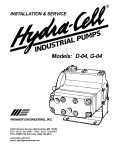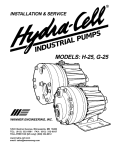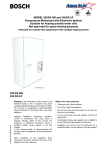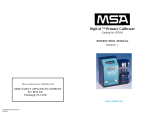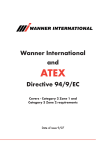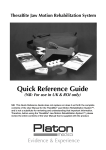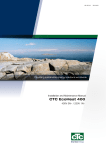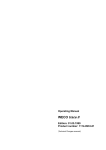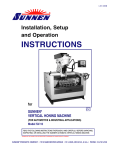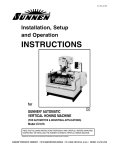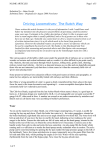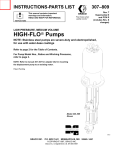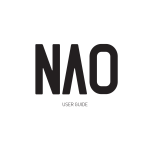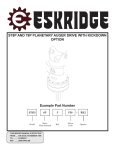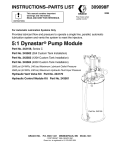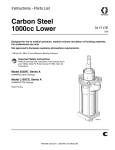Download F/G-20 Installation
Transcript
INSTALLATION & SERVICE S P M U P L A I R T S U D IN Models: F-20, F-21, F-22 G-20, G-21, G-22 WANNER ENGINEERING, INC. 1204 Chestnut Avenue, Minneapolis, MN 55403 TEL: (612) 332-5681 FAX: (612) 332-6937 TOLL-FREE FAX [US only]: (800) 332-6812 www.hydra-cell.com email: [email protected] F/G-20 Contents Page Specifications ......................................................................... 2 Dimensions ............................................................................ 4 Installation .............................................................................. 7 Maintenance ........................................................................ 11 Service (Fluid End) .............................................................. 12 Service (Hydraulic End) ....................................................... 15 Troubleshooting ................................................................... 18 F/G-20 Specifications Max Pressure Metallic: Non-Metallic: Calculating Required Horsepower (kW)* F/G-20: 1000 psi (70 bar); F/G-21/22: 1500 psi (100 bar) All Models: 250 psi (17 bar) Capacity @ Max Pressure rpm F/G-20-X 1750 F/G-20-E 1750 F/G-20-S 1750 F/G-20-B 1750 F/G-20-G 1750 2 x rpm gpm 0.96 0.73 0.55 0.33 0.20 I/min 3.63 2.76 2.08 1.25 0.76 63,000 2 x rpm 84,428 Delivery @ Max Pressure revs/gal revs/liter F/G-20-X 1823 500 F/G-20-E 2397 659 F/G-20-S 3182 906 F/G-20-B 5303 1400 F/G-20-G 8750 2302 Max Inlet Pressure + + gpm x psi = electric motor HP* = electric motor kW* 1,460 lpm x bar 511 * rpm equals pump shaft rpm. HP/kW is required application power. Use caution when sizing motors with variable speed drives. 100 psi (7 bar) Max Temperature Metallic Heads: 250°F (121°C) – consult factory for temperatures above 160°F (71°C) Non-Metallic Heads: 140°F (60°C) Inlet Port F-20: 1/2 inch NPT G-20: 1/2 inch BSPT Discharge Port F-20: 3/8 inch NPT G-20: 3/8 inch BSPT Shaft Diameter F-20: 5/8 inch hollow shaft for NEMA 56C C-Face motor (with feet) F-21/22: 5/8 inch G-20: 19 mm for IEC 80 B5 Flange motor (with feet) G-21/22: 19 mm Shaft Rotation Bi-directional Bearings Radial ball Oil Capacity 1/8 US quart (0.12 liters) Weight Metallic Head: 12 lbs (5.5 kg) Non-Metallic Head: 9 lbs (4.1 kg) Note: Performance and specification ratings apply to all configurations unless specifically noted otherwise. 2 F20-991-2400 5/1/04 F/G-20 Specifications Performance Net Positive Suction Head – NPSHr RPM 400 600 800 1000 1200 1400 1600 1800 22 20 6 18 F/G-20-X F/G-20-E F/G-20-S F/G-20-B F/G-20-G 1750 4.0 16 F/G-20-X 100 PSI (7 bar) 500 PSI (35 bar) 1000 PSI (70 bar) 1500 PSI (100 bar) NPSHr (feet of water) 1.0 3.5 3.0 0.8 5 14 4 12 10 3 8 2.5 0.6 F/G-20-S 2.0 2 6 Liters per Minute Gallons per Minute F/G-20-E NPSHr (meters of water) 200 1750 0 1.2 4 1 2 0 0 200 400 600 800 1000 1200 1400 1600 1800 RPM 1.5 0.4 Dry Lift F/G-20-B 1.0 1750 4.0 0.2 3.5 Lift (feet of water) 3.0 F/G-20-G 0 100 F/G-20-X 80 2.5 2.0 60 F/G-20-E F/G-20-S F/G-20-B F/G-20-G 1.5 40 Lift (cm of water) 0.5 1.0 20 0.5 0 0 200 400 600 800 1000 1200 1400 1600 1800 RPM Note: Performance and specification ratings apply to all configurations unless specifically noted otherwise. 3 F20-991-2400 5/1/04 F/G-20 Dimensions F-20/G-20 Models with Metallic Pumping Head Inches (mm) 3.64 (92.5) Brass 316 Stainless Steel Hastelloy® C Ø6.50 (165) Ø5.870 (149) 8.38 (213) F-20: 5/8" ID (for NEMA 56C) G-20: 19 mm ID (for IEC 80) 2.20 (55.9) Ø0.42 (10.7) 2.93 (74.4) Outlet F-20: 3/8" NPT G-20: 3/8" BSPT 0.72 (18.3) 4.15 (105) 0.65 (16.5) 3.25 (82.6) Inlet F-20: 1/2" NPT G-20: 1/2" BSPT 9.72 (247) 0.25 (6.4) F-20/G-20 Models with Non-Metallic Pump Head Kynar® 3.64 (92.5) Polypropylene Ø6.50 (165) Ø5.870 (149) 8.63 (219.2) F-20: 5/8" ID (for NEMA 56C) G-20: 19 mm ID (for IEC 80) 2.20 (55.9) 2.93 (74.4) Ø0.42 (10.7) Outlet F-20: 3/8" NPT G-20: 3/8" BSPT 0.72 (18.3) 4.15 (105) 0.65 (16.5) 3.25 (82.6) Inlet F-20: 1/2" NPT G-20: 1/2" BSPT 9.97 (253.2) 0.25 (6.4) 4 F20-991-2400 5/1/04 F/G-20 Dimensions F-21/G-21 Models with Metallic Pumping Head Brass 2.25 (57.2) Inches (mm) Ø0.33 (thru hole) (8.4) 3.45 (87.6) 316 Stainless Steel Hastelloy® C 2.12 (53.8) 5.18 (132) 8.93 (227) Ø0.50 (12.7) (thru hole 2 places) F-21: Ø5/8" G-21: Ø19 mm 0.96 (24.4) Outlet F-21: 3/8 NPT G-21: 3/8 BSPT 1.91 (48.5) 0.72 (18.3) 4.50 (114) 2.93 (74.4) 0.65 (16.5) 4.98 (127) Inlet F-21: 1/2" NPT G-21: 1/2" BSPT F-21/G-21 Models with Non-Metallic Pump Head Kynar® 2.25 (57.2) Ø0.33 (thru hole) (8.4) 3.45 (87.6) Polypropylene 2.12 (53.8) 5.18 (132) 9.18 (233.2) Ø0.50 (12.7) (thru hole 2 places) F-21: Ø5/8" G-21: Ø19 mm 0.96 (24.4) Outlet F-21: 3/8" NPT G-21: 3/8" BSPT 1.91 (48.5) 0.72 (18.3) 4.50 (114) 2.93 (74.4) 0.65 (16.5) 4.98 (127) Inlet F-21: 1/2" NPT G-21: 1/2" BSPT 5 F20-991-2400 5/1/04 F/G-20 Dimensions F-22/G-22 Models with Metallic Pumping Head Inches (mm) Brass 316 Stainless Steel Hastelloy® C Ø6.50 (165) Ø5.870 (149) 8.38 (213) Ø0.42 (10.7) (4 x) F-22: Ø5/8" G-22: Ø19 mm 5.63 (143) 2.93 (74.4) Outlet F-22: 3/8" NPT G-22: 3/8" BSPT 0.72 (18.3) 4.15 (105) 0.65 (16.5) Inlet F-22: 1/2" NPT G-22: 1/2" BSPT 9.72 (247) 7.09 (180) F-22/G-22 Models with Non-Metallic Pump Head Kynar® Polypropylene Ø6.50 (165) Ø5.870 (149) 8.63 (219.2) Ø0.42 (10.7) (4 x) F-22: Ø5/8" G-22: Ø19 mm 5.63 (143) 2.93 (74.4) Outlet F-22: 3/8" NPT G-22: 3/8" BSPT 0.72 (18.3) 4.15 (105) 0.65 (16.5) Inlet F-22: 1/2" NPT G-22: 1/2" BSPT 7.09 (180) 6 9.97 (253.2) F20-991-2400 5/1/04 F/G-20 Installation Location Important Precautions NOTE: The numbers in parentheses are the Reference Numbers on the illustrations found later in this manual and in the Parts Manual. Adequate Fluid Supply. To avoid cavitation and premature pump failure, be sure that the pump will have an adequate fluid supply and that the inlet line will not be obstructed. See “Inlet Piping”. Locate the pump as close to the supply source as possible. Install it in a lighted clean space where it will be easy to inspect and maintain. Allow room for checking the oil level, changing the oil, and removing the manifold (3) and valve plate (21). Positive Displacement. This is a positive-displacement pump. To avoid severe system damage if the discharge line ever becomes blocked, install a relief valve downstream from the pump. See “Discharge Piping”. Mounting Safety Guards. Install adequate safety guards over all pulleys, belts, and couplings. Follow all codes and regulations regarding installation and operation of the pumping system. The pump shaft can be rotated in either direction. To prevent vibration, securely attach the pump or motor to a rigid base. Shut-Off Valves. Never install shut-off valves between the pump and discharge pressure regulator, or in the regulator bypass line. On a belt-drive system, align the sheaves accurately: poor alignment wastes horsepower and shortens the belt and bearing life. Make sure the belts are properly tightened, as specified by the belt manufacturer. Freezing Conditions. Protect the pump from freezing. See also the Maintenance Section. On a direct-drive system, align the shafts accurately. Consult the Factory for the following situations: On a close-coupled system, coat the motor shaft liberally with Loctite® Nickel Anti-Seize #77164. • • • • • • 7 Extreme temperature applications (above 160° F or below 40° F) Pressure feeding of pumps Viscous or abrasive fluid applications Chemical compatibility problems Hot ambient temperatures (above 110° F) Conditions where pump oil may exceed 200° F because of a combination of hot ambient temperatures, hot fluid temperature, and full horsepower load — an oil cooler may be required F20-991-2400 5/1/04 F/G-20 Installation Inlet Piping (Suction Feed) Inlet Piping (Pressure Feed) CAUTION: When pumping at temperatures above 160° F (71°C), use a pressure-feed system. Provide for permanent or temporary installation of a vacuum/ pressure gauge to monitor the inlet vacuum or pressure. Pressure at the pump inlet should not exceed 250 psi (173 bar); if it could get higher, install an inlet pressure regulator. Do not supply more than one pump from the same inlet line. Install draincocks at any low points of the suction line, to permit draining in freezing conditions. Provide for permanent or temporary installation of a vacuum gauge to monitor the inlet suction. To maintain maximum flow, vacuum at the pump inlet should not exceed 7 in. Hg (180 mm Hg). Do not supply more than one pump from the same inlet line. Inlet Calculations Acceleration Head Calculating the Acceleration Head Supply Tank Use the following formula to calculate acceleration head losses. Subtract this figure from the NPSHa, and compare the result to the NPSHr of the Hydra-Cell pump. Use a supply tank that is large enough to provide time for any trapped air in the fluid to escape. The tank size should be at least twice the maximum pump flow rate. Ha = (L x V x N x C) ÷ (K x G) Isolate the pump and motor stand from the supply tank, and support them separately. where: Ha = Acceleration head (ft of liquid) L= Actual length of suction line (ft) — not equivalent length V= Velocity of liquid in suction line (ft/sec) [V = GPM x (0.408 ÷ pipe ID2)] N= RPM of crank shaft C= Constant determined by type of pump — use 0.628 for the F/G-20/21/22 Hydra-Cell pump K= Constant to compensate for compressibility of the fluid — use: 1.4 for de-aerated or hot water; 1.5 for most liquids; 2.5 for hydrocarbons with high compressibility G= Gravitational constant (32.2 ft/sec2) Install a separate inlet line from the supply tank to each pump. Install the inlet and bypass lines so they empty into the supply tank below the lowest water level, on the opposite side of the baffle from the pump suction line. If a line strainer is used in the system, install it in the inlet line to the supply tank. To reduce aeration and turbulence, install a completely submerged baffle plate to separate the incoming and outgoing liquids. Install a vortex breaker in the supply tank, over the outlet port to the pump. Friction Losses Place a cover over the supply tank, to prevent foreign objects from falling into it. Calculating Friction Losses in Suction Piping When following the above recommendations (under “inlet Piping”) for minimum hose/pipe I.D. and maximum length, frictional losses in the suction piping are negligible (i.e., Hf = 0) if you are pumping a water-like fluid. Hose and Routing Size the suction line at least one size larger than the pump inlet, and so that the velocity will not exceed 1-3 ft/sec (0.3 to 0.9 m/s): For pipe in inches: Velocity (ft/sec) = 0.408 x GPM/Pipe ID 2 When pumping more-viscous fluids such as lubricating oils, sealants, adhesives, syrups, varnishes, etc., frictional losses in the suction piping may become significant. As Hf increases, the available NPSH (NPSHa) will decrease, and cavitation will occur. For pipe in mm: Velocity (m/sec) = 21.2 x LPM/Pipe ID2 Keep the suction line as short and direct as possible. In general, frictional losses increase with increasing viscosity, increasing suction-line length, increasing pump flowrate, and decreasing suction-line diameter. Changes in suction-line diameter have the greatest impact on frictional losses: a 25% increase in suction-line diameter cuts losses by more than two times, and a 50% increase cuts losses by a factor of five times. Use flexible hose and/or expansion joints to absorb vibration, expansion, or contraction. If possible, keep the suction line level. Do not have any high points to collect vapor unless these high points are vented. To reduce turbulence and resistance, do not use 90° elbows. If turns are necessary in the suction line, use 45° elbows or arrange sweeping curves in the flexible inlet hose. If a block valve is used, be sure it is fully opened so that the flow to the pump is not restricted. The opening should be at least the same diameter as the inlet plumbing ID. Do not use a line strainer or filter in the suction line unless regular maintenance is assured. If used, it should have a freeflow area of at least three times the free-flow area of the inlet. Consult the factory before pumping viscous fluids. Minimizing Acceleration Head and Frictional Losses To minimize the acceleration head and frictional losses: • • • Install piping supports where necessary to relieve strain on the inlet line and to minimize vibration. • • 8 Keep inlet lines less than 1 ft (0.3 m) long (suction stabilizer required for longer inlet lines) Use at least 5/8 in. (16 mm) I.D. inlet hose Use soft hose (low-pressure hose, noncollapsing) for the inlet lines Minimize fittings (elbows, valves, tees, etc.) Use a suction stabilizer on the inlet. F20-991-2400 5/1/04 F/G-20 Installation Minimizing Acceleration Head and Frictional Losses Discharge Piping To minimize the acceleration head: Note: Consult the Factory before manifolding two or more pumps together. • • • Hose and Routing • • Keep inlet lines less than 3 ft (1 m) long Use at least 5/8” (16mm) I.D. inlet hose Use soft hose (low-pressure hose, noncollapsing) for the inlet lines Minimize fittings (elbows, valves, tees, etc.) Use a suction stabilizer on the inlet. Use the shortest, most-direct route for the discharge line. Select pipe or hose with a working pressure rating of at least 1.5 times the maximum system pressure. EXAMPLE: Select a 1500 psi (103 bar) W.P.-rated hose for systems to be operated at 1000 psi (69 bar) gauge pressure. Net Positive Suction Head Use about 6 ft (1.8 m) of flexible hose between the pump and rigid piping to absorb vibration, expansion or contraction. NPSHa must be equal to or greater than NPSHr. If not, the pressure in the pump inlet will be lower than the vapor pressure of the fluid— and cavitation will occur. Calculating the NPSHa Support the pump and piping independently. Size the discharge line so that the velocity of the fluid will not exceed 7-10 ft/sec (2-3 m/sec): Use the following formula to calculate the NPSHa: For pipe in inches: Velocity (ft/sec) = 0.408 x GPM/Pipe ID2 NPSHa = Pt + Hz - Hf - Ha - Pvp For pipe in mm: Velocity (m/sec) = 21.2 x LPM/Pipe ID2 where: Pressure Regulation Pt = Atmospheric pressure Install a pressure regulator or unloader in the discharge line. Bypass pressure must not exceed the pressure limit of the pump. Hz = Vertical distance from surface liquid to pump centerline (if liquid is below pump centerline, the Hz is negative) Size the regulator so that, when fully open, it will be large enough to relieve the full capacity of the pump without overpressurizing the system. Hf = Friction losses in suction piping Ha = Acceleration head at pump suction Pvp = Absolute vapor pressure of liquid at pumping temperature NOTES: Locate the valve as close to the pump as possible and ahead of any other valves. • In good practice, NPSHa should be 2 ft greater than NPSHr • All values must be expressed in feet of liquid Atmospheric Pressure at Various Altitudes Adjust the pressure regulating valve to no more than 10% over the maximum working pressure of the system. Do not exceed the manufacturer’s pressure rating for the pump or regulator. Altitude Pressure (ft) (ft of H 2O) 0 33.9 500 33.3 1000 32.8 Route the bypass line to the supply tank, or to the suction line as far as possible from the pump (to reduce the chance of turbulence). Altitude Pressure (ft) (ft of H 2O) 1500 32.1 2000 31.5 5000 28.2 If the pump will be operating for a long time with the discharge closed and fluid bypassing, install a thermal protector set to trip at 140° F in the bypass line (to prevent severe temperature buildup in the bypassed fluid). CAUTION: Never install shutoff valves in the bypass line or between the pump and pressure regulator or relief valve. Provide for permanent or temporary installation of a pressure gauge to monitor the discharge pressure at the pump. For additional system protection, install a safety relief valve in the discharge line, downstream from the pressure regulator. 9 F20-991-2400 5/1/04 F/G-20 Installation Before Initial Start-Up Initial Start-Up Procedure Before you start the pump, be sure that: 1. Turn on power to the pump motor. 2. Check the inlet pressure or vacuum. To maintain maximum flow, inlet vacuum must not exceed 7 in. Hg. Inlet pressure must not exceed 250 psi (17.3 bar). 3. Listen for any erratic noise and look for unsteady flow. 4. If the system has an air lock and the pump fails to prime: a. Turn off the power. b. Remove the pressure gauge or plug from the tee fitting at the pump outlet (refer to the illustration on page 3). NOTE: Fluid may come out of this port when the plug is removed. Provide an adequate catch basin for fluid spillage, if required. Fluid will come out of this port when the pump is started, so we recommend that you attach adequate plumbing from this port so fluid will not be sprayed or lost. Use high-pressure-rated hose and fittings from this port. Take all safety precautions to assure safe handling of the fluid being pumped. c. Jog the system on and off until the fluid coming from this port is air-free. d. Turn off the power. e. Remove the plumbing that was temporarily installed, and reinstall the pressure gauge or plug. 5. Adjust the discharge pressure regulator to the desired operating and bypass pressures. Do not exceed the maximum pressure rating of the pump. 6. After the pressure regulator is adjusted, set the “pop-off” safety relief valve at 100 psi higher than the desired operating pressure. 7. Pumps fitted with Teflon diaphragms require 2 psi (0.14 bar) minimum inlet pressure. • • • • • • All shut-off valves are open, and the pump has an adequate supply of fluid. All connections are tight. The oil reservoir beneath the reservoir diaphragm (71) is completely full. NOTE: The reservoir is filled and sealed at the factory. If you are unsure about the oil level, remove the cover (70) and slowly lift the diaphragm (71). Refer to Service Procedure #6, “Fill and Seal the Oil Reservoir”, in the FluidEnd Service Section. The relief valve on the outlet of the pump is adjusted so the pump starts under minimum pressure. All pulleys and belts are properly aligned, and belts are tensioned according to specification. All pulleys and belts have adequate safety guards. 10 F20-991-2400 5/1/04 F/G-20 Maintenance NOTE: The numbers in parentheses are the Ref. Nos. on the illustrations in the Parts Manual. Shutdown Procedure During Freezing Temperatures Periodically Take all safety precautions to assure safe handling of the fluid being pumped. Provide adequate catch basins for fluid drainage and use appropriate plumbing from drain ports, etc., when flushing the pump and system with a compatible antifreeze. Change the oil after the first 100 hours of operation, then change according to the guidelines below. When changing, remove the drain plug (69), Allow all oil and contaminant to drain out. 1. Adjust the discharge pressure regulating valve so the pump runs under minimum pressure. Stop the pump. 2. Drain supply tank; open any draincocks in system piping and collect drainage. Drain as much fluid from the pump manifold and plumbing attached directly to the pump manifold by loosening fittings or removing plugs or gauges. 3. Close draincocks in system piping and tighten or replace any fittings, gauges or plugs. 4. Fill supply tank with enough antifreeze to fill system piping and pump. NOTE: Disconnect the system return line from the supply tank and connect it to a separate reservoir. 5. Start the pump and allow it to run until the system is filled with antifreeze. NOTE: If the system has an airlock and the pump fails to prime, follow step 4 of the Initial Startup Procedure to clear the air. 6. When mostly antifreeze is flowing from the system return line, stop the pump. Connect the system return line back to the supply tank and circulate the antifreeze for a short period. 7. It is also good practice to change the oil in the hydraulic end before storage for an extended period. This will remove any accumulated condensation and sediment from the oil reservoir. Drain and refill the hydraulic end with the appropriate Hydra-Oil and operate the pump for a short period to assure smooth performance. Hours Between Oil Changes @ Various Process Fluid Temperatures RPM <90°F (32°C) <139°F (60°C) <180°F (82°C) Metallic Pump Head <1000 psi (70 bar) <1200 <1800 6,000 3,000 4,000 2,000 2,000 1,500 <1500 psi (100 bar) <1200 <1800 3,000 1,500 2,000 1,000 1,500 1,000 Non-Metallic Pump Head <250 psi (17 bar) <1200 <1800 3,000 1,500 2,000 1,000 — — Pressure NOTE: Minimum oil viscosity for proper hydraulic end lubrication is 16-20 cST (80-100 SSU). CAUTION: Do not turn the drive shaft while the oil reservoir is empty. There should be no trapped air under the oil reservoir diaphragm (71). Refer to Service Procedure #6, “Fill and Seal the Oil Reservoir”, in the Fluid-End Service Section. Use the appropriate Hydra-Oil for the application (contact Wanner Engineering if in doubt). CAUTION: If you are losing oil but don’t see any external leakage, or if the oil becomes discolored and contaminated, the diaphragm (22) may be damaged. Refer to the FluidEnd Service Section. Do not operate the pump with a damaged diaphragm. CAUTION: Do not leave contaminated oil in the pump housing or leave the housing empty. Remove contaminated oil as soon as discovered, and replace it with clean oil. Check the inlet pressure or vacuum periodically with a gauge. CAUTION: Protect the pump from freezing. Refer also to the “Shutdown Procedure”. 11 F20-991-2400 5/1/04 F/G-20 Service (Fluid End) See Hydraulic End for pump housings Bolt Torque Specifications Ref. No. 1 20 22 23 F-20/21/22 (in-lbs) 90 14 10 14 G-20/21/22 (Ncm) 1,017 158 113 158 12 F20-991-2400 5/1/04 F/G-20 Service (Fluid End) NOTE: The number in parentheses are the Reference numbers on the illustration at right (also shown in the Parts Manual). 3. Inspect and Replace Diaphragm (22) This section explains how to disassemble and inspect all easilyserviceable parts of the pump. Repair procedures for the hydraulic end (oil reservoir) of the pump are included in a later section of the manual. a. Use a 3-mm Allen wrench to remove the two capscrews (20) from the valve plate (21). b. Lift the diaphragm by one edge, and turn the pump shaft until the diaphragm moves up to “top dead center”. This will expose machined cross holes in the plunger shaft behind the diaphragm. NOTE: If the pump has a hollow shaft, use the shaft rotator from the Wanner Tool Kit. c. Insert the plunger holder (from the Wanner Tool Kit) through one of the machined cross holes, to hold the diaphragm up. The proper size tool is included in the Wanner Tool Kit. (Don’t remove the tool until the new diaphragm is installed in step “G” below). d. Unscrew the diaphragm. Use an 8-mm or 5/16-in. openend wrench, and turn counterclockwise. e. Inspect the diaphragm carefully. A damaged diaphragm generally indicates a pumping system problem, and replacing only the diaphragm will not solve the larger problem. Inspect the diaphragm for the following: • Small puncture. Usually caused by a sharp foreign object in the fluid, or by an ice particle. • Diaphragm pulled away from the sides. Usually caused by fluid being frozen in the pump, or by overpressurization of the pump. • Diaphragm becoming stiff and losing flexibility. Usually caused by pumping a fluid that is incompatible with the diaphragm material. • Diaphragm edge chewed away. Usually caused by overpressurizing the system. CAUTION: If a diaphragm has ruptured and foreign material or water has entered the oil reservoir, do not operate the pump. Check the diaphragm, then flush the reservoir completely (as outlined below) and refill it with fresh oil. Never let the pump stand with foreign material or water in the reservoir, or with the reservoir empty. f. Clean away any spilled oil. Apply Loctite #242 Threadlocker to the threads of the new diaphragm (or the old one, as appropriate). g. Install the diaphragm and tighten to 10 in-lbs. NOTE: All bolts, nuts, and screws are metric sizes. CAUTION: Do not disassemble the hydraulic end unless you are a skilled mechanic. For assistance, contact Wanner Engineering (612-332-5681) or the distributor in your area. 1. Remove Manifold (3) a. Remove all eight bolts (1) around the manifold. b. Remove the manifold (3). c. Inspect the manifold for warping or wear around the inlet and outlet ports. If wear is excessive, replace the manifold or return it to Wanner Engineering for resurfacing. To check if the manifold is warped, place a straightedge across it. A warped manifold should be replaced. 2. Inspect Valves (4-17) The inlet and outlet valve assemblies are different (the inlet valve is larger) and face in opposite directions. Inspect each valve as follows: a. Check the spring retainers (4,17), and replace if worn. b. Check the valve springs (5,16). If shorter than a new spring, replace them (do not just stretch the old spring). c. Check the valve poppets (6,15). If worn excessively, replace them. d. Remove the valve seats (9,13). A seat puller is included in the Wanner Tool Kit. Inspect the valve seats for wear, and replace if necessary. A new O’ring (8,12) should be installed. e. Check the dampening washers (10,11), and replace if worn. f. Reinstall the valve assemblies: • Clean the valve ports and shoulders with emery cloth, and lubricate them with lubricating gel or petroleum jelly (do not use petroleum products when installing EPDM O-rings). • Install the O-rings (8,12) on the valve seats (9,13). • Inlet Valve. Insert the spring retainer (17) into the valve plate, then insert the spring, valve, Tetra seal, valve seat, and dampening washer (16 - 11). A flat O-ring [Tetra seal] (14) goes between the retainer and seat. • Outlet Valve. Insert the dampening washer, valve seat, Tetra seal, valve, and spring, then the retainer. Install the flat O-ring between the retainer and seat. 13 F20-991-2400 5/1/04 F/G-20 Service (Fluid End) 4. Flush Contaminant from Hydraulic End (only if a diaphragm has ruptured) 6. Fill and Seal the Oil Reservoir a. The oil reservoir diaphragm (71) protrudes down into the pump housing approximately 1/4 to 3/8 in. Add oil, if required, so that when the diaphragm is set into the reservoir all air is pushed out. Take care not to allow any oil overflow to get between the pump housing (62 or 66) and the cover (54). This may result in an apparent oil leak later, when the pump is put into use and heats up. b. Install the cover (70) using the four bolts. c. Wipe off any excess oil that got squeezed out onto the outside of the pump housing. NOTE: The diaphragm (71) will flex up and down slightly as the pump operates. The vent holes in the reservoir cover (70) allow this action to freely occur. a. With the valve plate and manifold still removed (see above), remove the oil drain cap (69), and the oil reservoir cover (70) and diaphragm (71). Allow all oil and contaminant to drain out. b. Fill the reservoir with kerosene or solvent, manually turn the pump shaft to circulate the kerosene, and drain. Dispose of this contaminated fluid properly. CAUTION: If you have an EPDM diaphragm, or if food grade oil is in the reservoir, do not use kerosene or solvents. Instead, flush with the same lubricant that is in the reservoir. Pumps with an EPDM diaphragm have an “E” as the 7th digit of the Model No. c. Repeat the flushing procedure (step “b” above). d. Fill the reservoir with fresh oil, manually turn the pump shaft to circulate the oil, and drain once again. e. Refill the reservoir. If the oil appears milky, there is still contaminant in the reservoir. Repeat the flushing procedure until the oil appears clean. 7. Reinstall Valve Plate (21) and Manifold (3) a. Reinstall the valve plate (21), with the valve assemblies installed as outlined above, onto the diaphragm plate (24). b. Reinstall the O-rings (18,19) onto the valve plate (21). Use petroleum jelly or lubricating gel to hold them in place (do not use petroleum products when installing EPDM O-rings). c. Reinstall the manifold onto the valve plate. d. Insert all bolts (1) around the edge of the manifold, and alternately tighten opposite bolts until all are secure. Torque to 90 in.-lbs. e. Recheck all bolts for tightness. 5. Prime the Hydraulic Cell a. With the pump horizontal, fill the reservoir with the appropriate Hydra oil for the application. b. All air in the oil within the hydraulic cell (behind the diaphragm) must be forced out by turning the shaft — and thus pumping the piston. A shaft rotator is included in the Wanner Tool Kit. Turn the shaft until a bubble-free flow of oil comes from behind the diaphragm. Watch the oil level in the reservoir; if it gets too low during priming, air will be drawn into the piston (inside the hydraulic end). This will cause the pump to have a loss in flow, and you will have to start over again with priming the hydraulic cell. Fill oil reservoir completely. Add diaphragm seal and install cover plate. c. Wipe excess oil from the cover plate and diaphragm. 14 F20-991-2400 5/1/04 F/G-20 Service (Hydraulic End) F/G-21Pump Housing F/G-20 and F/G-22 Pump Housing F/G-21 and F/G-22 Shaft and Keyway F/G-20 Only F/G-20 Hollow Shaft See Fluid End for Piston Assembly Bolt Torque Specifications Ref. No. 50 52 72 75 F-20/21/22 (in-lbs) 35 14 10 35 G-20/21/22 (Ncm) 396 158 113 396 15 F20-991-2400 5/1/04 F/G-20 Service (Hydraulic End) NOTE: The numbers in parentheses are the Reference numbers on the illustration at right (also shown in the Parts Manual). To Remove Motor from DirectCoupled Unit (F20) This section explains how to disassemble and inspect the hydraulic end (oil reservoir) of the pump. 1. Disassemble Motor from Pump CAUTION: Do not disassemble the hydraulic end unless you are a skilled mechanic. For assistance, contact Wanner Engineering (612-332-5681) or the distributor in your area. a. Remove the four bolts and flat washers that secure the pump and motor together. b. Install two of the bolts into the threaded holes in the pump flange (51). c. Alternately turn the bolts clockwise until the pump and motor separate. Depending on the repair you are attempting, you may or may not have to remove the motor from a direct-drive pump/motor unit. Internal piston components (26 - 32) can be serviced without removing the motor or crankshaft. The motor and crankshaft must be removed to service the connecting rod (59), piston (33), crankshaft (58), front bearing (60), back bearing (57), or seal (56). 2. Reassemble Motor to Pump a. Thoroughly clean the motor shaft and the hollow pump shaft. b. Apply a liberal amount of Loctite Nickel Anti-Seize #77164 to the pump shaft. c. Install the shaft key into the motor shaft keyway. d. Slide the motor shaft into the hollow pump shaft. CAUTION: When assembling this pump to the directcoupled motor, be careful that the shaft key remains in the motor shaft keyway and does not ride up the keyway and contact the shaft seal (which would cause premature seal failure). Incorrect key placement could also cause the hollow pump shaft to fail. Use a screwdriver to move the shaft key back in the motor shaft keyway as the motor and pump are drawn together. e. Reinstall the four bolts and flat washers. To Service Piston Without Removing Motor or Crankshaft 1. Disassemble Piston a. b. c. d. Remove the manifold, valve plate, diaphragm plate and diaphragm, and drain the oil from the pump (see the Fluid-End Service Section): Remove the snap ring (26) from the piston, using a standard #1 snap-ring pliers. Pull out the valve plunger (29). This also removes the washer (27) and spring (28). (31), and pull the cylinder out of the piston. Be careful not to damage the piston. Inspect all parts, and replace the O-ring and any other parts that are worn or may be damaged. To Service Remainder of Hydraulic End 1. Remove Pump Housing 2. Reassemble Piston a. Remove the manifold, valve plate, and diaphragm, as outlined in the Fluid-End Service Section. b. Drain the oil from the pump housing by removing the drain plug (69), and the oil reservoir cover (70) and diaphragm (71). c. Stand the pump on end, with the drive shaft up. d. Remove the bolts (52) that secure the cover (54) to the housing (62 or 66). Use a 5-mm socket wrench. Save the O-rings (53). e. Remove the cover and the cover O-ring (55). f. Remove the crankshaft (58) by pulling it through the connecting rod (59). a. Tip the pump so the piston is upright. b. Drop the ball (32) into the opening in the bottom of the piston. c. Insert the valve plunger (29) into the valve cylinder (31). Slide the spring (28) over the plunger, inside the valve cylinder. d. Slide the assembled valve cylinder, plunger, and spring (28 - 31) into the piston (33). e. Insert the washer (27) over the plunger. f. Using the snap-ring pliers, insert the snap ring (26) into the piston. 16 F20-991-2400 5/1/04 F/G-20 Service (Hydraulic End) 2. Remove and Replace Piston 5. Reinstall Diaphragm To remove the piston (33), first remove the connecting rod (59) and pin (61) by pressing the pin through the connecting rod. Reverse the process to reinstall the piston. Refer to Steps 5 and 6 below to replace the diaphragm and reassemble the pump. a. Screw the plunger puller (from the Wanner Tool Kit or Repair Kit) into the plunger (29). Pull out to expose the cross hole in the plunger. Rotate the shaft until the piston is at top dead center. b. Insert the diaphragm wrench (from the Wanner Tool Kit), or similar dowel-type object, through the plunger hole — to hold the plunger away from the diaphragm plate (24), and to keep the plunger from turning when the diaphragm is being installed. c. Apply a small amount of Loctite #242 to the threads of the diaphragm (be sure the threads are clean). d. Set the diaphragm (22) on the plunger (29), ridge-side out. Screw the diaphragm onto the plunger. e. Hold the diaphragm wrench, and tighten the diaphragm to 10 in.-lbs of torque. f. Fill the reservoir with fresh oil and prime the pump, as outlined in the Fluid-End Service Section. 3. Reassemble Housing and Casting NOTE: Inspect the shaft seal (56) before continuing. If it looks damaged in any way, replace it. Refer to “Replace Shaft Seal” below. a. Stand the pump on end. b. With the piston and connecting rod in place, reinstall the crankshaft by threading it through the connecting rod. c. Reinstall the cover, cover O-ring, and bolts (with their Orings). 6. Reassemble Pump Fill and seal the oil reservoir, then reassemble the pump as outlined in the Fluid-End Service Section. 4. Replace Shaft Seal a. Press the back bearing (57) and seal (56) out of the cover (54). Discard the seal. b. Apply a coating of Loctite High-Performance Pipe Sealant With Teflon®, or a comparable product, to the outer surface of a new seal and the inside surface of the opening in the back cover (54) where the seal will rest. c. Press the new seal into the back cover. d. Inspect the bearing (57). If pitted or damaged, replace it. 17 F20-991-2400 5/1/04 F/G-20 Troubleshooting Cavitation Pump Runs Rough • • • • • • • • • Inadequate fluid supply caused by: – Inlet line collapsed or clogged – Clogged line strainer – Inlet line too small or too long – Air leak in inlet line – Worn or damaged inlet hose – Suction line too long – Too many valves and elbows in inlet line – NPSHa is less than NPSHr Fluid too hot for inlet suction piping system. Air entrained in fluid piping system. Aeration and turbulence in supply tank. Inlet suction vacuum too high. • • • • • • • Premature Failure of Diaphragm (22) Symptoms of Cavitation • • • • Worn pump valves Airlock in outlet system Oil level low Wrong weight of oil for cold operating temperatures (change to lighter weight) Cavitation Air in suction line Restriction in inlet/suction line Hydraulic cells not primed after changing diaphragm (22) Foreign material in inlet or outlet valve Damaged diaphragm (22) Broken valve spring (5,16) Excessive pump valve noise Premature failure of spring or retainer (4,5,16,17) Volume or pressure drop Rough-running pump • • • • • Drop in Volume or Pressure Frozen pump Puncture by a foreign object Elastomer incompatible with fluid being pumped Pump running too fast Excess pressure A drop in volume or pressure can be caused by one or more of the following: Water in Oil Reservoir • • • • • • • • • • • • • • • • • • • • • • • • • Air leak in suction piping Clogged suction line or suction strainer Suction line inlet above fluid level in tank Inadequate fluid supply Pump not operating at proper RPM Relief valve bypassing fluid Worn pump valve parts Foreign material in inlet or outlet valves Loss of oil prime in cells because of low oil level Ruptured diaphragm (22) Cavitation Warped manifold from overpressurized system O-rings forced out of their grooves from overpressurization Air leak in suction line strainer or gasket Cracked suction hose. Empty supply tank Excessive aeration and turbulence in supply tank Abrasives in the fluid Valve incompatible with corrosives in the fluid Pump running too fast Worn and slipping drive belt(s) Worn spray nozzle(s) • Condensation Ruptured diaphragm (22) Hydraulic cell not properly primed after diaphragm (22) replacement Frozen pump Strong Water Pulsations NOTE: Small pulsations are normal with a single-acting pump. • • • • • • 18 Foreign object lodged in pump valve Loss of prime in hydraulic cell because of low oil level Air in suction line Valve spring (5,16) broken Cavitation Aeration or turbulence in supply tank F20-991-2400 5/1/04 F/G-20 Troubleshooting Valve Wear • Normal wear Pump Runs, But Fluid Doesn’t Flow • Unit air-locked Loss of Oil • • • • • • External seepage Rupture of diaphragm (22) Frozen pump Worn shaft seal Oil drain, fill cap, or oil reservoir cover loose Valve plate and manifold bolts loose Premature Failure of Valve Spring or Retainer • • • • Cavitation Foreign object in the pump Pump running too fast Spring/retainer material incompatible with fluid being pumped 19 F20-991-2400 5/1/04 Limited Warranty Wanner Engineering, Inc. extends to the original purchaser of equipment manufacturerd by it and bearing its name, a limited one-year warranty from the date of purchase against defects in material or workmanship, provided that the equipment is installed and operated in accordance with the recommendations and instructions of Wanner Engineering, Inc. Wanner Engineering, Inc. will repair or replace, at its option, defective parts without charge if such parts are returned with transportation charges prepaid to Wanner Engineering, Inc., 1204 Chestnut Avenue, Minneapolis, Minnesota 55403. This warranty does not cover: 1. The electric motors (if any), which are covered by the separate warranties of the manufacturers of these components. 2. Normal wear and/or damage caused by or related to abrasion, corrosion, abuse, negligence, accident, faulty installation or tampering in a manner which impairs normal operation. 3. Transportation costs. This limited warranty is exclusive, and is in lieu of any other warranties (express or implied) including warranty of merchantability or warranty of fitness for a particular purpose and of any noncontractual liabilities including product liabilities based on negligence or strict liability. Every form of liability for direct, special, incidental or consequential damages or loss is expressly excluded and denied. WANNER ENGINEERING, INC. 1204 Chestnut Avenue, Minneapolis, MN 55403 TEL: (612) 332-5681 FAX: (612) 332-6937 TOLL-FREE FAX [US only]: (800) 332-6812 www.hydra-cell.com email: [email protected] ©2004 Wanner Engineering, Inc. Printed in USA 20 F20-991-2400 5/1/04




















